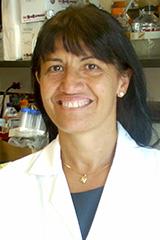Neuromuscular Medicine
Below are labs and faculty conducting groundbreaking research on neuromuscular disorders, translating basic science research into new and more effective clinical trials and interventions.
To learn about ongoing clinical trials or participate in a study, visit the clinical trials page for our Division of Neuromuscular Disease.
Labs
Deng LabDr. Deng’s lab is focused on understanding the mechanism of neurodegenerative diseases such as amyotrophic lateral sclerosis (ALS).
Dr. Deng’s lab is focused on understanding the mechanism of neurodegenerative diseases such as amyotrophic lateral sclerosis (ALS).
Visit Dr. Deng's faculty profile for more information.
Kalb LabDr. Kalb’s lab studies the activity-dependent development of circuits in the central nervous system and neurodegenerative diseases.
Dr. Kalb’s lab studies the activity-dependent development of circuits in the central nervous system and neurodegenerative diseases.
Research Description
Glutamatergic synapses that include the GluA1 subunit have a privileged role in activity-dependent brain development and this is driven, in part, through the assembly of a large multi-protein complex in the post-synaptic density. A critical molecular component of this complex is the scaffolding protein SAP97. Among the >90 known SAP97 binding partners we have determined that a novel protein called CRIPT plays an essential role in this process. Humans with mutations in CRIPT have a severe developmental brain disorder. We are using a variety of approaches to understand the mechanisms by which CRIPT controls synapse biology and dendrite growth including: 1) study of a conditional knock-out (cKO) mouse that we built, 2) super-resolution imaging of glutamate receptors/TARPs/MAGUKs using neurons derived from patient iPS cells and 3) electrophysiology of dissociated neurons and hippocampal slices from the cKO mice. Insight into the molecular logic of SAP97/CRIPT function will have implications for childhood maladies such as intellectual disability and autism/autism-spectrum disorders.
In our studies of adult onset neurodegenerative diseases such as Amyotrophic Lateral Sclerosis and Frontotemporal Dementia we find evidence for maladaptive changes in cellular intermediary metabolism and proteostasis. Ongoing metabolomics interrogations are uncovering why changes in fuel utilization are toxic and discovering new targets for therapeutic intervention. The relationship between altered metabolism and perturbed protein homeostasis is also an area of intense interest with special focus on a proteasome adaptor protein called RAD23. Our experimental platforms are: 1) cells from patients with various genetic abnormalities (i.e., mutations in C9orf72, TDP43, etc.) differentiated into neurons, 2) C.elegans, and 3) primary rat/mouse neurons. Targeting proximal events in neurodegenerative diseases will lead to novel therapeutic approaches.
For lab information and more, visit Dr. Kalb's faculty profile or the Kalb Lab website.
Publications
See Dr. Kalb's publications on PubMed.
Contact
Contact Dr. Kalb at 312-503-5358
Kiskinis LabDr. Kiskinis’ lab investigates the molecular mechanisms that give rise to neurological diseases using human stem cell-derived neuronal subtypes.
Dr. Kiskinis’ lab investigates the molecular mechanisms that give rise to neurological diseases using human stem cell-derived neuronal subtypes.
Research Description
The broad objective of our laboratory is to understand the nature of the degenerative processes that drive neurological disease in human patients. We are primarily interested in Amyotrophic Lateral Sclerosis (ALS), Epileptic Syndromes as well as the age-associated changes that take place in the Central Nervous System (CNS). We pursue this objective by creating in vitro models of disease. We utilize patient-specific induced pluripotent stem cells and direct reprogramming methods to generate different neuronal subtypes of the human CNS. We then study these cells by a combination of genomic approaches and functional physiological assays. Our hope is that these disease model systems will help us identify points of effective and targeted therapeutic intervention.
For more information view the faculty profile of Evangelos Kiskinis, PhD, or the Evangelos Kiskinis Lab site.
Publications
View Dr. Kiskinis' publications at PubMed.
Contact
Evangelos Kiskinis, PhDAssistant Professor of Neurology
Menichella LabDr. Menichella’s lab investigates the molecular and physiological mechanisms underlying neuropathic pain in hereditary and acquired peripheral neuropathies.
Dr. Menichella’s lab investigates the molecular and physiological mechanisms underlying neuropathic pain in hereditary and acquired peripheral neuropathies.
Lab Description
Menichella's lab is especially focused on painful diabetic neuropathy (PDN). PDN is a debilitating affliction present in 26% of diabetic patients with substantial impact on their quality of life. Despite this significant prevalence and impact, current therapies for PDN are only partially effective. Moreover, the molecular and electrophysiological mechanisms underlying neuropathic pain in diabetes are not well understood.
Neuropathic pain is caused by sustained excitability in sensory neurons which reduces the pain threshold, so that pain is produced in the absence of appropriate stimuli. Towards designing more effective therapeutics, our goal is to identify the molecular and physiological mechanisms that shape sustained excitability in sensory neurons responsible for the transition to neuropathic pain in peripheral neuropathies. More specifically we are investigating the role of molecules involved in inflammation such as chemokine and the potential role of microRNAs.
We take advantage of an integrated approach combining pain behavioral tests, electrophysiology studies including current clamp recordings, in vitro and in vivo calcium imaging studies, confocal studies with conditional and transgenic mouse genetic and chemo-genetic silencing of sensory neuron subtypes using mutated hM4D receptor (DREADD) receptors.
Publications
For more publication information see PubMed and for more information see the faculty profile of Daniela Maria Menichella, MD/PhD.
Contact
Daniela Maria Menichella, MD, PhD
312-503-3223
Ozdinler LabDr. Ozdinler’s lab studies the cortical component of motor neuron circuitry degeneration in amyotrophic lateral sclerosis (ALS) and other related disorders.
Dr. Ozdinler’s lab studies the cortical component of motor neuron circuitry degeneration in amyotrophic lateral sclerosis (ALS) and other related disorders.
Research Description
We are interested in the cellular and molecular mechanisms that are responsible for selective neuronal vulnerability and degeneration in motor neuron diseases. Our laboratory especially focuses on the corticospinal motor neurons (CSMN) which are unique in their ability to collect, integrate, translate and transmit cerebral cortex's input toward spinal cord targets. Their degeneration leads to numerous motor neuron diseases, including amyotrophic lateral sclerosis, hereditary spastic paraplegia and primary lateral sclerosis.
Investigation of CSMN require their visualization and cellular analysis. We therefore, generated reporter lines in which upper motor neurons are intrinsically labeled with eGFP expression. We also characterized progressive CSMN degeneration in various mouse models of motor neuron diseases and continue to generate reporter lines of disease models, in which the upper motor neurons express eGFP.
The overall goal in our investigation, is to develop effective treatment strategies for ALS and other related motor neuron diseases. We appreciate the complexity of the disease and try to focus the problem from three different angles. In one set of studies, we try to reveal the intrinsic factors that could contribute to CSMN vulnerability by investigating the expression profile of more than 40,000 genes and their splice variations at different stages of the disease. In another set of studies, we try to understand the role of non-neuronal cells on motor neuron vulnerability and degeneration, using a triple transgenic mouse model, in which the cells that initiate innate immunity are genetically labeled with fluorescence in an ALS mouse model. These studies will not only reveal the genes that show alternative splice variations, but also inform us on the canonical pathway and networks that are altered with respect to disease initiation and progression.
Even though the above mentioned studies, which use pure populations of neurons and cells isolated by FACS mediated approaches, will reveal the potential mechanisms that are important for CSMN vulnerability, it is important to develop therapeutic interventions. One of the approach we develop is the AAV-mediated gene delivery directly into the CSMN via retrograde transduction. Currently, we are trying to improve CSMN transduction upon direct cortex injection.
Identification of compounds that support CSMN survival is an important component of pre-clinical testing. We develop both in vitro and in vivo compound screening and verification platforms that inform us on the efficiency of compounds for the improvement of CSMN survival.
In summary, we generate new tools and reagents to study the biology of CSMN and to investigate both the intrinsic and extrinsic factors that contribute to their vulnerability and progressive degeneration. We develop compound screening and verification platforms to test their potency on CSMN and develop AAV-mediated gene delivery approaches. Our research will help understand the cellular basis of CSMN degeneration and will help develop novel therapeutic approaches.
For more information see the faculty profile of Pembe Hande Ozdinler, PhD or the Ozdinler Lab website.
Visit the Les Turner ALS Center
Publications
View Dr. Ozdinler's full list of publications at PubMed.
Contact
Phone: 312-503-2774
Research Faculty
Ajroud-Driss, Senda
Professor, Neurology (Neuromuscular Disease)
Deng, Han-Xiang
Research Professor, Neurology (Neuromuscular Disease)
Kalb, Robert G
Professor, Neurology (Neuromuscular Disease)
Kiskinis, Evangelos
Associate Professor, Neurology (Neuromuscular Disease), Neuroscience
Menichella, Daniela Maria
Associate Professor, Neurology (Neuromuscular Disease), Pharmacology
Ozdinler, Hande
Associate Professor, Neurology (Neuromuscular Disease)
Mojsilovic-Petrovic, Jelena
Research Assistant Professor, Neurology (Neuromuscular Disease)
Seth, Arjun
Assistant Professor, Neurology (Neuromuscular Disease)
Simkin, Dina
Research Assistant Professor, Neurology (Neuromuscular Disease)
Sufit, Robert L
Professor, Neurology (Neuromuscular Disease), Surgery (Organ Transplantation)









